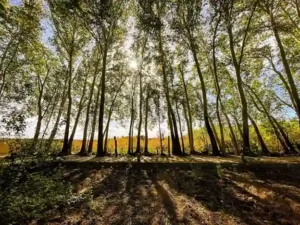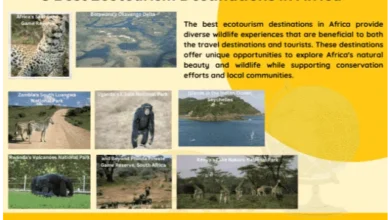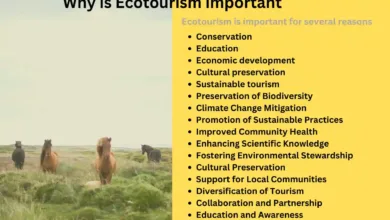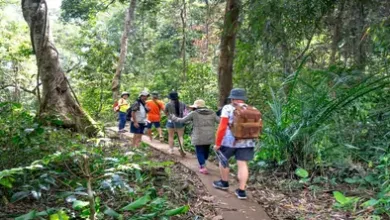
What is Ecotourism? Meaning, Examples and Advantages
Ecotourism is a form of tourism that involves traveling to natural areas with the purpose of learning. It is based on the idea of visiting and experiencing the natural world, promoting conservation, sustainability and preserving natural environments.
The goal of ecotourism is to educate tourists and provide them with a deeper appreciation and understanding of the natural world and about the environment.
It is a way of vacationing or visiting places that emphasize natural features while reducing environmental effects. Not only for nature it is a positive experience for both tourists and locals.
In this article a detailed guide about ecotourism, activities, examples and advantages of ecotourism.
What is mean by Ecotourism?
Ecotourism involves responsible travel to natural areas that prioritize conservation, community well-being, and education. This type of tourism is made possible through collaboration between global organizations, individuals, and the tourism industry, all focused on educating tourists and professionals about environmental concerns.
Ecotourism activities include.
- Hiking, birdwatching, wildlife viewing.
- Water adventures, mountain biking, caving, climbing.
- Trekking and camping in protected areas.
- Cultural experiences with local communities
- Educational experiences.
- Tree-planting experiences.
- Flora, fauna, and natural resources.
- Sustainable wilderness adventures.
Examples of ecotourism
These are only a few types of the numerous ecotourism activities that are offered. Ecotourism seeks to attract tourists by offering them unusual and instructive experiences while also promoting environmental awareness and protection.
Here are some specific examples of ecotourism activities.
Hiking and Trekking:
This involves exploring natural areas on foot and observing the local flora and fauna.
Snorkeling or Diving.
This involves exploring underwater ecosystems and observing marine life in their natural habitats.
Nature and Wildlife Photography.
Photographers can capture the beauty of the natural environment and wildlife, while also learning about the animals and their habitats.
Camping and Glamping.
Ecotourism camping and glamping experiences allow tourists to stay in natural areas and observe the local environment and wildlife.
Eco-Lodges.
Eco-lodges provide a unique and sustainable accommodation experience, while also promoting environmental awareness and conservation.
Eco-Adventure Tours
These tours involve activities such as kayaking, rafting, and zip lining, while also promoting environmental awareness and conservation.
Ethical Elephant Encounters.
This involves interacting with elephants in a responsible and ethical manner, promoting their conservation and well-being.
Instances of ecotourism locations.
Listed below are a few instances of ecotourism locations:
-
The Galapagos Islands
Located in Ecuador, are well-known for their indigenous biodiversity, including iguanas and Galapagos tortoises.
-
Monteverde Cloud Forest, Costa Rica
Costa Rica is a paradise for environmentally minded tourists with a ton of ecotourism activities. Additionally, the nation has set aside a fourth of its landmass as reserves, national parks, and other protected areas. More than 100 species of animals, 1,200 species of amphibians and reptiles, 400 species of birds, and other endemic plant and animal species can also be found in the cloud forest reserve of Monteverde, which gets its name from the Spanish word for “green mountain.
-
The Canadian Banff National Park
Area with a variety of outdoor recreation opportunities, such as hiking, skiing, and animal viewing.
-
Kenya’s Masai Mara National Reserve
A place where lions, elephants, and giraffes can be found in large numbers.
-
Palau
This little island in the Pacific Ocean is revolutionizing ecotourism. Palau has launched an app-based rewards program where tourists may accrue points for protecting the island nation’s delicate ecosystem.
-
The Amazon Rainforest in Brazil
A large environment that allows for wildlife observation, river boat cruises, and jungle trekking.
-
Indonesia’s Komodo National Park
A protected area that is home to the Komodo dragon, the largest lizard in the world, as well as a diverse marine ecosystem that includes coral reefs, mangroves, and seagrass beds.
-
Australia’s Great Barrier Reef
The world’s biggest coral reef system, a UNESCO World Heritage Site, and a well-liked snorkeling and scuba diving location.
-
Slovenia
Slovenia needs to be acknowledged more for its ecotourism efforts. Forests encompass 60% of the nation, and 54% of its area is designated as protected. Visitors swarm to Slovenia to experience its breathtaking natural beauty, whether they choose to hike one of its magnificent mountains or boat across Lake Bled.
-
Cape Town, South Africa
A place renowned for its natural splendor, including Table Mountain and the Cape of Good Hope, as well as its profusion of wildlife, including whales and dolphins.
-
Gothenburg, Sweden
It is regarded as one of the world’s top eco-tourism attractions and is the second-largest city in Sweden. Over 90% of the hotels are eco-certified, and the public transportation in this formerly industrial port town is primarily powered by renewable energy. The dense forests that surround the city provide a significant amount of open space in the form of parks, meadows, extensive bicycle paths, and hiking trails.
-
Gurung Mulu National Park, Malaysia
The national park, which is known for its enormous cave networks and abundant wildlife, is tucked away on the island of Borneo in the State of Sarawak. Along with having steep peaks, deep gorges, and tranquil rivers, it is also a UNESCO World Heritage site. One of the world’s most unusual geological formations can be found there.
-
Koh Kong, Cambodia
One of the well-liked ecotourism locations in Southeast Asia is Cambodia. A hidden gem, the province of Koh Kong is home to lush mangrove forests, clear rivers, tropical islands with undeveloped beaches, and a wealth of biodiversity, including several endangered species.
-
The Burren, Ireland
The location’s name comes from the Irish term “Boreann,” which means a rocky area. Seventy percent of Ireland’s native plant species can be found in The Burren, one of the island nation’s special places with a moon-like scenery and a diverse ecosystem.
Advantages of Ecotourism:
There are some advantages of ecotourism.
Conservation
By funding conservation initiatives and increasing public awareness of the value of conservation, ecotourism can aid in the protection and preservation of delicate natural regions.
Economic benefits to local communities
Helps local communities financially by generating jobs and supporting the growth of small enterprises.
Cultural exchange
Enables cross-cultural interactions between visitors and the local population, fostering respect and understanding.
Educational value
Ecotourism gives visitors the chance to learn about the local culture and ecology and to gain a deeper understanding of the natural world.
Development goal of ecotourism
Ecotourism has the potential to generate new jobs, bring in significant financial resources that can be used to help lift entire communities out of poverty, and provide crucial technology and resources to underdeveloped areas that can aid in the achievement of development goals. Ecotourism results in massive development projects Like roads, hotels, resorts, etc.
Sustainable development.
It helps to promote sustainable development by encouraging ecologically friendly behaviors and reducing adverse environmental effects.
Economic benefits
Supports local communities. Encourages cultural preservation by giving indigenous peoples the chance to share their traditions and knowledge with tourists. Contributes to conservation efforts by raising money for protected areas and conservation projects.
Incentives to increase biodiversity and protect the environment:
By generating jobs, ecotourism can combat poverty and strengthen nearby indigenous communities. encourages conservation.
Honoring the local people and their traditions.
Learning about new customs and traditions will be a personal eye-opener for any traveler while interacting with nature in a more profound way. By choosing ecotourism and eco-practices, while also educating yourself and participating in distinctive, genuine traditions
Research opportunities and better management.
As more people see nature up close and become passionate about maintaining it, ecotourism may result in expanded research opportunities and better management techniques.
Eco-friendly travel can only increase one’s knowledge and consciousness of oneself and others, about the need to learn more about sustainable practices and preserve the natural world.
Conclusion
Ecotourism is a responsible form of travel that prioritizes conservation, community well-being, and education. It offers unique experiences that promote environmental awareness and preservation, and offers activities such as hiking, snorkeling, camping, and eco-lodges.





